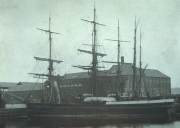Whaling Home | Tools of the Trade | Next
The Whale Ships

In the arctic trade whaling vessels were in the order of 120 feet long. By modern standards this was quite small (just about twice as long as a big whale that they hoped to catch). Prior to 1857 only sailing ships were used. These were converted from general trading vessels for the purpose. This was done by adding extra planking around the hull, and also strengthening them internally by the use of additional cross-timbers. Ships were usually three-masted barks. They were manned by a crew of about 50. This was far more than were required to actually sail the vessel, because of the need for extra hands while hunting whales. Living conditions, particularly for the ordinary seaman who lived in the fo'castle, were very overcrowded.

In 1857, steam powered was introduced to whalers as a trial. This was so successful that by the 1859 season the first custom-built steam whaler was in use by the Dundee fleet. The Tay was built in the town by Alexander Stephen and Sons (later to become as famous as Stephen's of Linthouse on the Clyde). She weighed 455 tons and had a 75 horsepower engine. She was the first of a series of the new breed of arctic whaling ships to be launched by the yard. The ships looked much the same as their sailing counterparts (they still had masts and rigging and could often sail faster than they could steam). The only addition was a funnel indicating the presence of an engine. Although the engines were not powerful by modern standards, they were sufficient to give the ships the edge over sailing competitors on the hunting grounds. They were known as auxiliary powered vessels. These steam ships led the Dundee fleet to rise to supremacy in Scottish whaling until the cessation of the industry in around 1912.
Most importantly, whaling vessels were made of wood. This allowed them to withstand the pressures of the ice when steaming through or when trapped fast in freezing ice. It is recorded that one ship from Dundee was so severely squeezed in the ice that her hatches were diamond-shaped instead of square when she eventually returned to port. The important thing of course was that she survived, her crew were safe and her catch was available for sale. She was repaired and continued to sail to the whaling in succeeding years. Steel and iron ships were tried but all were lost and they were deemed unsuitable for the trade.

The prowess of Arctic whalers in ice conditions was what led Captain Robert Scott to come to Dundee. He went to the same yard that had built all its whalers, to utilise the expertise of its workers in wooden ship construction. They built Discovery for his first Antarctic expedition in 1901. He also used the old whaler Terra Nova for his second voyage in 1910.